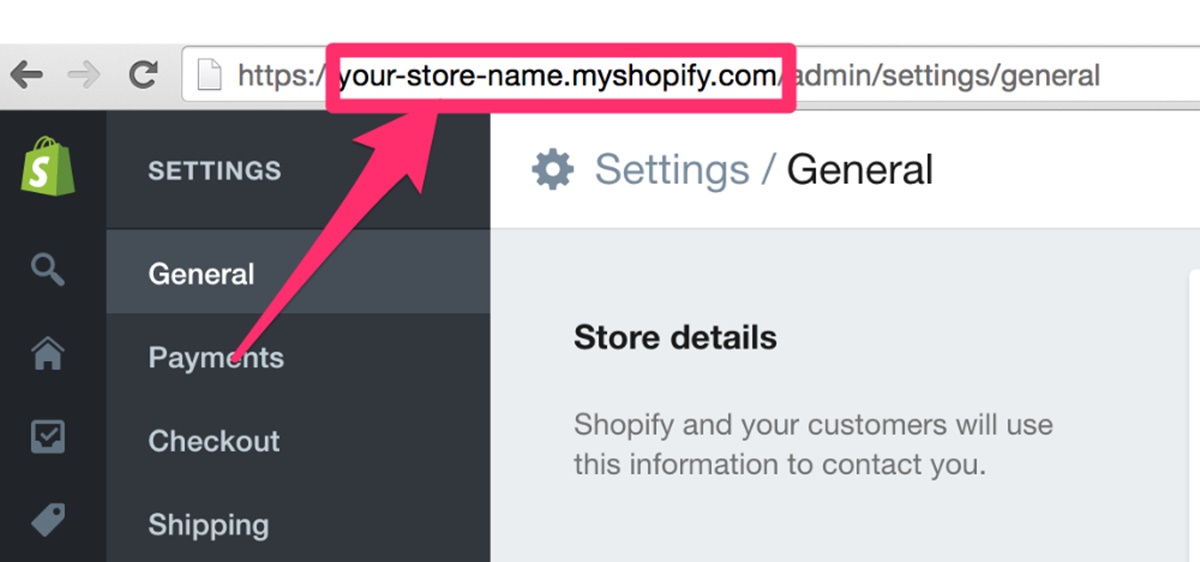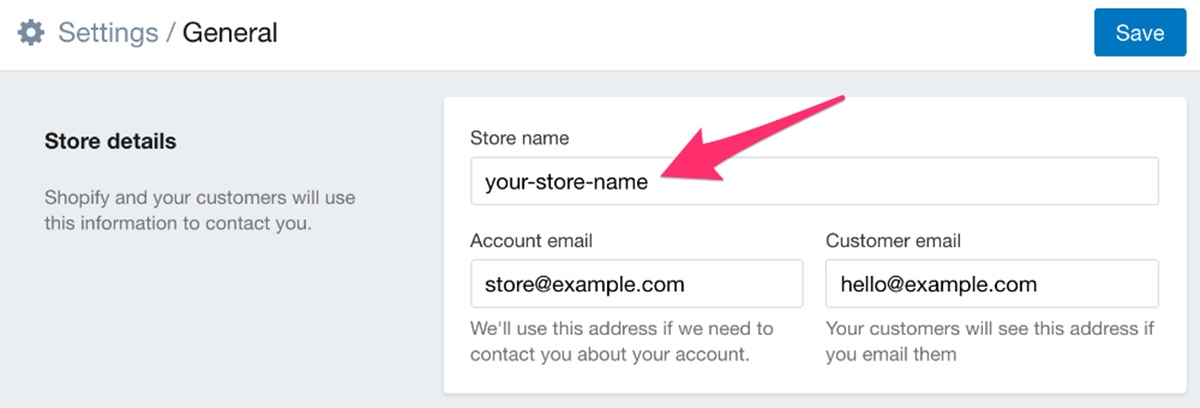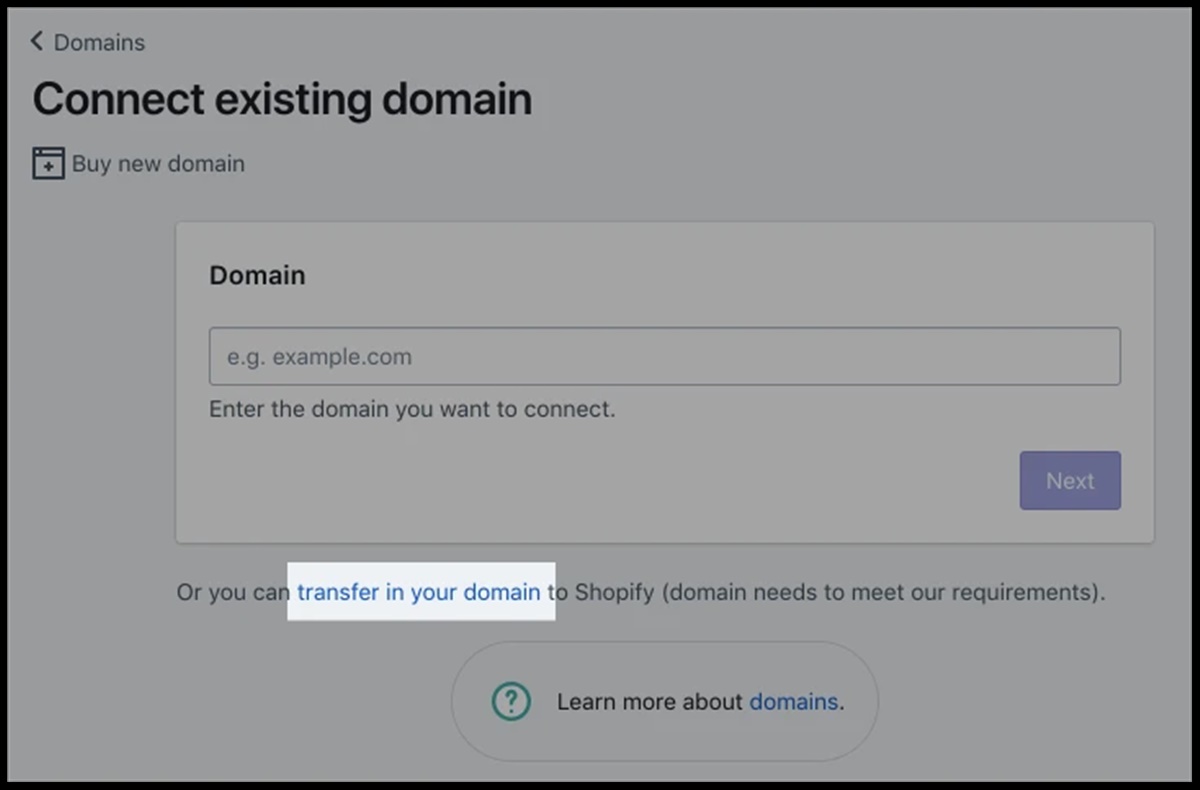How to Find and Set Up Shopify Store Address?
A business needs a name, so does a website; it requires an address. A Shopify Store Address aims to simplify the “calling” of an online store to view content on that website.
If your Shopify shop does not have an address (domain name), it will be difficult for users to remember what the store’s website is, and then the computer network will understand by the IP address, for example: 206.192.1.1. It is hard to remember for most people. Therefore, registering a domain name for a website is a must, and do it as soon as possible.
Below is a detailed guide for you to find and set up your Shopify store address.
What is a Shopify store address?
A Shopify store address is a website address, known as a URL (unified resource locator). Without the address or unknown address of a website, customers or visitors cannot access your website.

Thus, it can be said that the website address is a tool to lead customers and visitors to your website. This is extremely important for an online store, because, despite having a beautiful interface and good product quality without access, your website will be considered an “empty house”. This does not work and you have to spend a lot of money to maintain it.
The website address starts with the protocol, unique name, domain name, and ends with the port number. Examples of protocols used are HTTP and https. Next, a unique name obtained by a domain name registration service is used. The domain name is listed after the unique name, and the port number is listed or assumed at the end. A variety of different domain names exist, including but not limited to: .com, .net, .org and .gov.
For your online store, you handle your domain settings on the Domains tab of your Shopify admin. If you are using the wholesale platform, you will be handling the domain settings for your wholesale store in that platform on the Domains tab.
Your primary domain is the domain you see when people access your Shopify website. Your primary domain, by default, is your myshopify domain that appears like your-store-name.myshopify.com. When you contact Shopify Support, you need your myshopify domain to log in to your shop and define your account.
Once you have your myshopify domain, you cannot change it. Instead, you can either purchase a new domain or use the one you already own.
How to find a Shopify store address?
Your storefront address for Shopify is the default address that Shopify gives you when you first open your shop. It will be in the format: your_shop_name.myshopify.com.
If you can’t recall your shop address, you can seek it by logging into your Shopify admin. You can find your shop name in two ways:
The first way is to find your store address by going to the Store name field on your General Settings page. Your shop name should be visible there:

The second way you can find your Shopify address is to look at the URL after logging into your Shopify admin. Your store name will be included in that URL:

If you have a custom domain name connected to your Shopify shop, you still need to improve your original storefront address, which given by Shopify for Craftybase connection.
How to set up your own Shopify store address?
Transferring a domain to Shopify
When you convert a domain, the domain management moves to Shopify, which means renewing your domain, paying for your domain, and adjusting your domain settings directly in your Shopify admin. Shopify does not provide email addresses as part of its domain services but does provide the web domain with unrestricted email forwarding accounts.
You need to have your domain registered more than 60 days ago to switch a domain to Shopify and access your first domain vendor account.
Be aware that you will need to track and respond to crucial confirmation emails to move your domain, and wait until the move is complete for up to 20 days from initiation. You would also have to pay to keep your domain registered for another year. For instance, if you still possess 3 months until your domain takes effect and then transfer your web address to Shopify, you will add up to that 12 months of registration. This means that the domain will not need to be extended for 15 months.
Below is a step-by-step guide for you to transfer a domain to Shopify.
1. Test the transfer policy of your domain service provider
Most service providers support transfers of domains. Until you start the transfer process test the transfer policy for your domain provider.
The best and quickest way to find that is to check for the transfer domain in the domain provider’s help center. For some typical domain providers, here are transfer policies:
2. Prepare your domain for transfer
You need to prepare your domain for conversion before you can move it to Shopify.
Step 1: Use your third-party domain provider account to log in.
Step 2: Confirm that your account associated email is valid. You will receive emails to this account, which you need to reply to during the domain transfer process. If you are connecting your current email address to your domain, it will be deactivated during transfer.
Step 3: You expect to transfer the domain, you have to unlock it first. This will generally involve discovering the domain settings you wish to transfer, and then tap Unlock. In a confirmation email, some domain providers require you to authorize this selection by clicking on a link.
Step 4: Get your provider’s transfer authorization code. This usually includes finding the domain settings you wish to transfer, then pressing Transfer this domain or Transfer out.
Note: The procedure by third party domain supplier to prepare a domain for transition varies. If you have difficulty planning to move your domain, then notify your third-party domain provider. Shopify Help can’t log in to your third party domain account even though you send your express permission to do so.
3. Transfer your domain
Your domain needs to be activated before you transfer your domain, so you have to get a transfer authorization code.
Step 1: In your Shopify admin page, make sure to click Online Store. A drop-down menu will appear and then select Domains.
Step 2: If it is the first domain connected to your Shopify shop, you need to tap on the Connect existing domain. Afterward, go to transfer in your domain.

If you already own one connected to your Shopify shop, then choose Transfer domain:

Step 3: Type the domain you want to add to Shopify. Remember that it must have no www. at the beginning.
Step 4: In this step, press Next.
Step 5: Tap on the Verify domain.
Step 6: If the domain is ready for transfer you will see DOMAIN UNLOCKED. Hit Next to proceed. When viewing DOMAIN LOCKED, please ensure that you have prepared your domain for transfer.
Step 7: Type the authorization code or EPP code given to you by your domain provider in the Verification code box.
Step 8: Select the Next button.
Step 9: Now, choose the Buy and transfer.
Step 10: Check your domain-related email account. You can have an email demanding verification of those changes depending on your domain provider. The email varies, but by clicking a link like Approve Transfer or Confirm Transfer, you must approve the domain transfer.
Once you have approved the domain transfer, it takes up to 20 days to complete the transfer. You’ll receive an email from Shopify confirming the transfer of your domain.
Note: When you transfer a domain to Shopify, the default domain records of its A record and CNAME record are set to the Shopify. If there were additional records on your domain before the change, you’d add those to your Shopify administrator’s Domains list. For example, you would need to add an MX record to reconnect the domain to an email hosting solution.
Connect an existing domain to Shopify
Connect your domain of a third party to Shopify points your domain name to your Shopify store, which means that if anyone enters your unique URL in their internet browser, they will be taken to your online store. You can use third-party domain service to control your domain settings, renew your domain, and pay for it.
1. Add a domain to your Shopify store
Caution: Unanticipated issues can occur when you are using proxies from third parties. Shopify shall not be kept liable for any information loss.
First of all, add your custom domain to your Shopify store. This move establishes you as the owner of your custom domain.
Step 1: Login your Shopify account and then go to the Online Store on the admin page. In the drop-down menu, make sure to click Domains.
Step 2: In this step, select the Connect existing domain.
Step 3: Type the domain that you expect to connect - for instance, johns-apparel.info.
Step 4: Press Next to continue.
You must now configure your existing domain to figure to Shopify.
2. Set up your current domain to connect to Shopify
If you have bought your domain through a 3rd party, then the following DNS settings must be modified:
-Your A record should point to the IP address 23.227.38.65 of Shopify.
-Your record of www CNAME should point to shops.myshopify.com.
Editing these domain settings could affect other things, like email forwarding. To find out how changes might affect your DNS settings, you can contact your domain provider.
Some domain vendors, such as GoDaddy, Hover, Google, and 1&1 IONOS, set up the domains for you automatically, in different ways.
Note: You may only assign one A record to your primary domain. If you already connect your domain with an A record while changing your DNS settings to point your A record to Shopify’s IP address, then delete the old A record.
Step 1: Sign in the account you have with your domain provider.
Step 2: Find your settings on DNS. Search for your field of domain control, DNS setup, or something similar.
Step 3: Edit your A file to point to IP address 23.227.38.65 of Shopify.
The panel of domain settings may feature editable fields or drop-downs or need to checkboxes or edit a list. You have to:
-
Enter or select the @ symbol, or A record.
-
Enter the IP address of Shopify
23.227.38.65as the endpoint for record A.
Step 4: Save A record (click Save Zone File, Save, Add record, or the like).
Step 5: From your DNS settings, look for the CNAME record.
Step 6: Edit your www CNAME record to point to shops.myshopify.com. Often you just need to enter the prefix without the dot, but you need the entire subdomain for some domain suppliers. Using existing entries as a reference or follow the instructions offered by your provider. CNAME records always have to point to a domain name and never an IP address.
Step 7: Save the CNAME Record (usually by clicking Add record or Save or the like).
Now, it’s time for you to check your connection in Shopify.
3. Verify your connection in Shopify
In this section, you need to back to your Shopify admin page. Then, click Verify connection to confirm that your store has connected with your custom domain.
Note: It could take up to 48 hours to point your custom domain to your online store. If you have difficulties with your third-party domain or need help setting it up, you can contact your provider.
Conclusion
A Shopify Store Address plays a vital part in whether or not customers come to your store. It’s like a home address because that’s how people find you on Shopify and on the internet. That’s why we call the bar at the top of the web browser the address bar - that’s where you enter your Shopify Store Address (domain name) to find your online shop.
This article has taken you through how to Find and Set Up your Shopify Store Address in detail. I do hope you find it easy to take steps. If you have any questions, Avado would love to answer.





